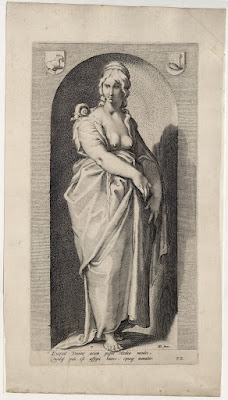Jacob Matham (15719–1631)
“Sloth” (La
Paresse), 1593, after Hendrik Goltzius (aka Hendrick Goltzius) (1558–1617) from
the series “The Virtues and the Seven Deadly Sins” / “The Vices”
Engraving on
laid paper with margins lined onto a conservator’s support sheet
Size: (sheet)
39.2 x 22.1 cm; (plate) 32.5 x 17 cm
Lettered in
lower right corner "HG. Inue." and numbered in lower left corner
"7". With two lines in the margin "Excecat .... moratur."
by "F.E." (Franco Estius).
New Hollstein
(Dutch & Flemish) 156 (Jacob Matham) (F W H Hollstein 1993, The New
Hollstein: Dutch and Flemish etchings, engravings and woodcuts 1450–1700,
Amsterdam); Hollstein 283 (F W H Hollstein 1949, “Dutch and Flemish etchings,
engravings and woodcuts c.1450–1700”, Amsterdam); New Hollstein (Dutch & Flemish)
498-504 (Hendrick Goltzius; Prints after inventions by Goltzius); Bartsch
III.165.138 (Adam Bartsch 1803, “Le Peintre graveur”, 21 vols, Vienna); TIB 4
(3).138 (165) (Walter L Strauss 1980, “The Illustrated Bartsch: Netherlandish
Artists”, vol. 4 [formerly vol. 3 (Part 2)]. p.127)
See also
Rijksmuseum: http://hdl.handle.net/10934/RM0001.COLLECT.382353
The British
Museum offers the following description of this print:
“Sloth; a
female figure, whole-length, with a snail on her shoulder, in a niche. 1593 Engraving”
The curator of
the BM also gives the following information about the series:
“This is one
from a series of seven numbered plates by Jacob Matham (New Hollstein 150-156)
after Goltzius …. The set was first published by Goltzius in Haarlem; then by
Claes Jansz Visscher in Amsterdam (before 1652); and finally by Jochem Ottens.
Seven preparatory drawings by Goltzius are in the Montreal Museum of Fine Arts,
inv.nos.Dr.975.2-8 (Reznicek 89-95). (http://www.britishmuseum.org/research/collection_online/collection_object_details.aspx?objectId=1480416&partId=1&searchText=1857,0613.510&page=1)
Condition:
crisp, richly inked impression laid upon a conservator’s support sheet. There
is a flatten crease in the margin at top right, a small wormhole (on the far right) and slight
age toning and minor marks at the lower edge of the sheet otherwise the print is in
excellent condition for its age.
I am selling
this marvellous impression of a very important print by Matham after Goltzius
(Matham’s stepfather) for the total cost of AU$390 (currently US$298.52/EUR276.63/GBP139.89
at the time of posting this listing) including postage and handling to anywhere
in the world.
If you are
interested in purchasing this female personification of sloth with a snail on
her shoulder in a niche, please contact me (oz_jim@printsandprinciples.com) and
I will send you a PayPal invoice to make the payment easy.
This print has been sold
This evening I
asked my cook whether the abstract notion of sloth would be explained well if
an illustrator were to show a bare-breasted woman set in a niche with a snail
crawling down her shoulder. My cook—who knows everything—looked me in the eye and said slowly and with absolute certainty: “…it’s just not nice.” I guess that the audience
that Matham was addressing with this engraving way back in the 16th
century held very different ideas.
Leaving aside my
cook’s insightful and persuasive argument against showing women in ways that
are simply “not nice,” I am fascinated by how this image is constructed. For
instance, if I start at the top of this personification of laziness I find
myself looking at her from a slightly elevated—perhaps even god-like—position
as I can see the very top of her head and gaze down her features to her breasts.
Once I have lowered my gaze to her chest, my position from which I look at her
changes as well. I am now at her thighs looking slightly up at her hands. My
position of looking at her again slips further down until I reach the ground
and from this position of a worm I look upwards. These changes of viewpoint are
amazing and no doubt they also signify meanings about sloth that I am yet to
fully digest.
Note also how
the figure is arranged so that this epitome of sloth is set away
from the viewer in what might be described as the socially removed “public
space” of her architectural niche. Counteracting this spatial and social distance,
is the very subtle use of the projecting toes of her right foot that extend beyond
the niche into the viewer’s “private space.”
In short, the
symbolism of this figure with its slowly moving snail has a complex layering of
meanings that are worth taking the time to contemplate … but I will leave that
task to others with a better understanding of laziness.







No comments:
Post a Comment
Please let me know your thoughts, advice about inaccuracies (including typos) and additional information that you would like to add to any post.